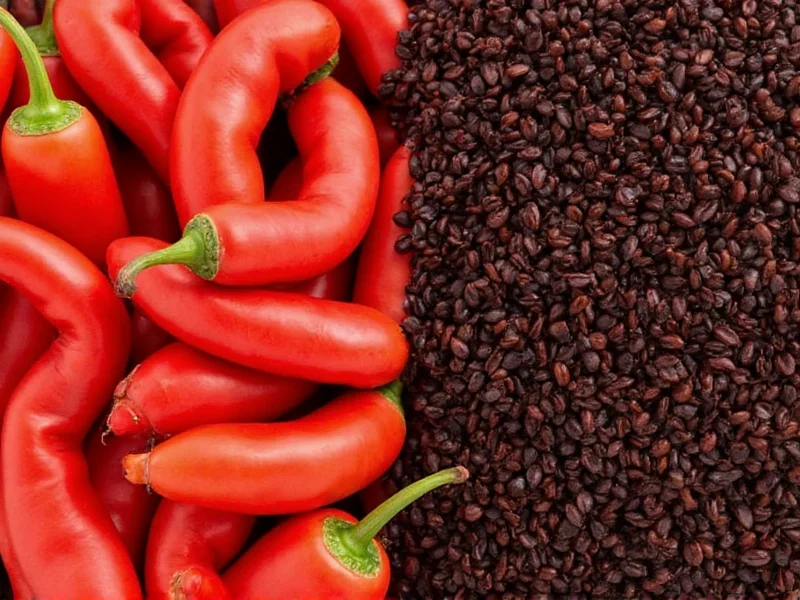Understanding the difference between ancho and pasilla chiles is essential for authentic Mexican cooking. Many home chefs mistakenly treat these dried peppers as interchangeable, leading to disappointing results in traditional recipes. This comprehensive comparison clarifies their unique characteristics, helping you select the right chile for your culinary creations.
Physical Characteristics: Shape, Color, and Size
Ancho chiles, which are dried poblanos, typically measure 4-6 inches long and 2.5-4 inches wide. They have a distinctive heart-shaped, flat appearance with deep reddish-brown to mahogany coloration. When rehydrated, they maintain a relatively thick, leathery skin.
Pasilla chiles (dried chilacas) are noticeably different in form. They're longer and narrower, usually 6-8 inches in length but only about 1 inch wide. Their color ranges from dark brown to nearly black, earning them the name "pasilla" which means "little raisin" in Spanish. The skin appears more wrinkled than anchos.
| Characteristic | Ancho Chile | Pasilla Chile |
|---|---|---|
| Original Fresh Pepper | Poblano | Chilaca |
| Shape | Wide, flat, heart-shaped | Long, thin, wrinkled |
| Color | Reddish-brown to mahogany | Dark brown to black |
| Typical Size | 4-6" x 2.5-4" | 6-8" x ~1" |
| Heat Level (SHU) | 1,000-2,000 | 1,000-2,500 |
Flavor Profiles and Heat Comparison
The flavor distinction between ancho chile vs pasilla represents one of the most significant differences for cooks. Anchos deliver a sweet, mildly fruity profile with pronounced notes of dried fruit, particularly raisins and prunes, along with subtle hints of tobacco and coffee. Their heat registers as mild on the Scoville scale, making them accessible even to those with low spice tolerance.
Pasilla chiles offer a more complex flavor journey. They begin with earthy, almost mushroom-like notes, develop into smoky characteristics, and finish with subtle berry undertones. While their heat range overlaps with anchos, pasillas often register slightly higher on the Scoville scale, providing a more pronounced warmth without overwhelming heat.
When considering ancho chile substitute options for pasilla (or vice versa), understanding these flavor differences is crucial. Substituting one for the other significantly alters a dish's character. Anchos work better in mole negro when you want pronounced sweetness, while pasillas contribute the necessary earthiness for authentic Oaxacan mole.
Culinary Applications and Traditional Uses
Ancho chiles shine in specific Mexican dishes where their sweet, fruity notes enhance complex sauces. They're essential in:
- Mole poblano
- Adobo sauces
- Certain enchilada sauces
- Tamales with sweet elements
- Chile con carne variations
Pasilla chiles play starring roles in different traditional preparations:
- Mole negro (Oaxacan black mole)
- Rajas con crema
- Certain pipián sauces
- Chile pasilla marinades for meats
- Traditional Mexican mole coloradito
Professional chefs note that understanding pasilla vs ancho heat level comparison helps balance recipes. While both fall in the mild-to-medium range, pasillas' slightly higher heat and earthier profile make them better suited for robust meat dishes, while anchos complement poultry and sweeter preparations.
Common Confusion and Regional Naming Issues
The confusion between ancho and pasilla chiles stems from inconsistent naming practices across regions. In some parts of the United States, particularly in older cookbooks, "pasilla" has been incorrectly used to refer to anchos. This mislabeling creates significant problems for cooks following traditional recipes.
Authentic Mexican markets maintain the distinction: anchos come from poblanos, while pasillas come from chilacas. When shopping for authentic pasilla chiles, look for the long, thin, dark brown to black appearance rather than the wider, reddish-brown anchos. This knowledge proves invaluable when following regional Mexican recipes that specify one chile over the other.
Substitution Guidance for Home Cooks
When you can't find authentic pasilla chiles, the best substitute combines mulato and guajillo chiles (equal parts) to approximate pasilla's earthy-smoky profile. For ancho chile substitute options, guajillo chiles work well but lack the same sweetness—adding a touch of sugar can help bridge the gap.
Never substitute one for the other directly in traditional recipes without adjusting other elements. In mole negro, replacing pasillas with anchos creates an overly sweet sauce that lacks depth. Conversely, using pasillas in mole poblano makes the sauce too earthy and diminishes the characteristic fruity notes.
Storage and Preparation Tips
Both dried chiles maintain quality for 6-12 months when stored properly in airtight containers away from light and moisture. Before use, always inspect for mold or off smells. Proper preparation involves:
- Removing stems and seeds (unless recipe specifies otherwise)
- Dry-toasting briefly in a skillet to enhance flavors
- Rehydrating in hot water for 15-20 minutes before blending
- Using the soaking liquid in sauces for maximum flavor extraction
When making ancho chile paste vs pasilla preparations, note that pasillas typically require slightly longer rehydration due to their thicker walls. This subtle difference affects texture in final sauces.











 浙公网安备
33010002000092号
浙公网安备
33010002000092号 浙B2-20120091-4
浙B2-20120091-4